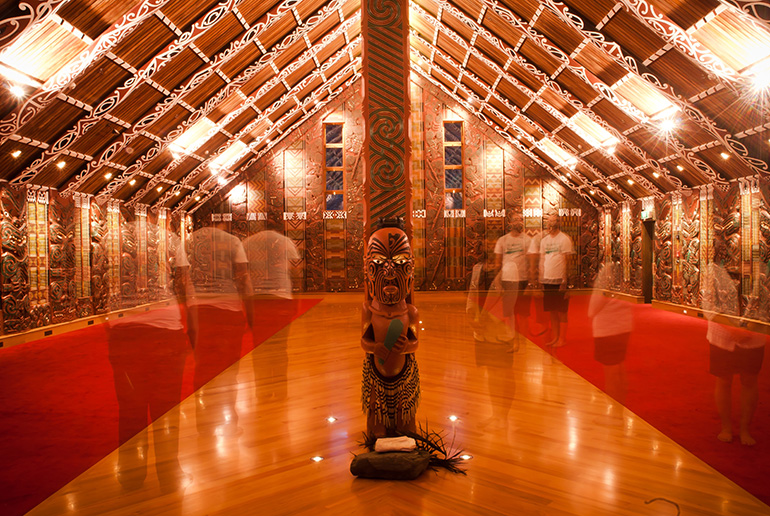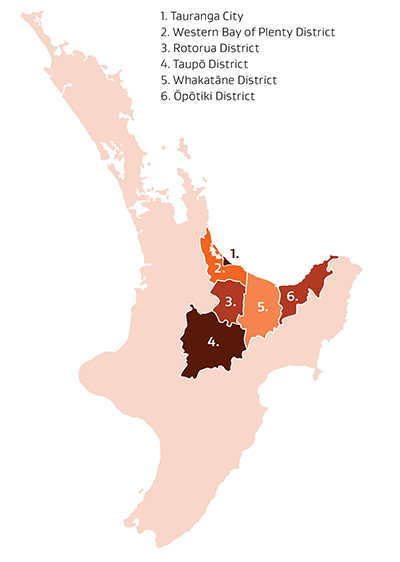Executive summary
On this page

© Toi EDA
The first Regional Workforce Plan for the Bay of Plenty endeavours to provide strategic focus for all stakeholders across the Bay who have an interest in regional workforce planning and labour market matters.

The Bay of Plenty Regional Skills Leadership Group (‘The Group’ or RSLG) is made up of iwi, community, business/industry and government representatives who first came together in September 2021 to develop the RWP. The Group is independent, but supported by the Ministry of Business, Innovation and Employment (MBIE), with a clear role to:
- Grow partnerships with iwi/Māori to understand and support their goals and aspirations, and to have a more confident, coordinated labour market view that supports Te Ao Māori and reflects the Government’s commitment to Te Tiriti o Waitangi
- Work with key stakeholders across the region and sub-regions to identify patterns, trends and priorities for business and labour market development, including workforce development needs now and in the future
- Identify and coordinate local actions that can address workforce development needs and improve employment and career opportunities for people in the region
- Use insights to influence the decision-making of local employers, workers, councils, government agencies, Economic Development Agencies, learners and jobseekers through improved information provision and planning capability.
The Group has built on the research, insights and recommendations of the interim Bay of Plenty Regional Skills Group[1] (BOP iRSLG), as well as considering the numerous economic development strategies and agendas across the Bay, along with the Bay of Plenty Labour Market Strategy report[2] produced by Bay of Connections, the Tertiary Intentions Strategy[3] (also produced by Bay of Connections) and multiple central and local government plans and programmes including the Government’s Employment Strategy.[4]
The Group followed an agreed national approach to the development of the RWP, namely:
- Aspirations: Identify labour market aspirations for the region.
- Analysis: Use statistical and forecast data, empirical insights and stakeholder engagement feedback to both test and refine the aspirations, and co-design potential actions.
- Action: Develop an action plan to achieve the outcomes articulated in the aspiration statements.
As the Bay of Plenty has an established network of Economic Development Agencies who have previously collaborated on strategies and plans, including work on tertiary education and labour market development, the Group was able to quickly build from a strong base of knowledge in developing this RWP.
The Group considered the key labour market challenges (‘what is the problem we are trying to solve?’) and the many existing interventions and actions (‘what is already underway?’) including skills, participation, productivity, and sub-regional economic drivers. They also looked closely at both the supply (people) and demand (business/industry) sides of the labour market, with a view to building tangible actions that address employment, training and education, and immigration matters.
The Group refined this comprehensive scope into five key aspirations that form the pillars in this plan. Once drafted, discussions and feedback from regional stakeholders helped further refine the thinking of the aspiration pillars, built on a strong foundation of Mā te Māori, Mō te Māori.
Regional workforce context
Our regional workforce context is characterised by our adherence to our Te Tiriti relationships which can be illustrated through the use of a Regional Workforce Whare comprising two sides or pou made up of Tāngata Aotearoa (whānau; hapū; iwi and Māori communities); and Tāngata Niu Tīreni (everyone else, including Māori communities in the context of Article 3 of Te Tiriti).
The RSLG’s role is as enabler and facilitator that affirms and maintains the tino rangatiratanga of whānau, hapū, iwi and Māori communities. This is an important way to support all those involved in the implementation of the RWP to give effect to Te Tiriti o Waitangi, as well as reflecting equity issues at the local and regional levels.
As an enabler and facilitator, the RSLG will:
- Co-lead the Mā te Māori, Mō te Māori approach
- Lead Tāngata Niu Tīreni
Co-design an iwi-Māori lead and designed workplan, Tāngata Aotearoa
- Advocate for time, space and resource to implement the Tāngata Aotearoa aspirations; and
- Propose and lead arrangements to enhance understanding across industries, providers, and other stakeholders.
The Group acknowledges the tireless work of local iwi and hapū on the frontline of the COVID response over the last two years. The kotahitanga (unity) of local iwi and hapū was a key pillar in local and national COVID response efforts that enabled support and resources to be quickly distributed directly to whānau during the lockdowns. During this time, with iwi and hapū heavily involved in COVID-response across the region, the Group acknowledges that it was not able to adequately consult with iwi. The Group used this time to articulate the relevance and opportunities for iwi within the work of the RWP. Now that the pressures of the COVID response have gradually begun to ease, the Group intends to engage more fulsomely on the RWP directly with iwi / Māori.
The Group wish to partner with regional Māori collectives, such as Te Kāhui Mātauranga, who can:
- Co-lead the Mā te Māori, Mō te Māori approach
- Co-design Tāngata Aotearoa
- Provide expertise in the application of āhuatanga Māori (Māori elements) according to tikanga
- Bring a network of relationships and enable collaboration, collective engagement, and feedback with and from iwi and Māori communities.
This plan details both the challenges and opportunities the Group considered for each aspiration area, with a list of actions needed to create a positive impact and outcome for each. Substantive literature and data is contained in the report appendices to support consideration of each of the five aspiration areas.
The Group acknowledge that the issues and opportunities they are trying to address for the Bay of Plenty region are vast, and that this action plan is not an exhaustive list. However, the Group has focused on five key areas where they believe they can have the most impact, while intentionally challenging the current state to authentically build on a positive economic future for the Bay.
The Group will now begin to work with stakeholders on the immediate and short-term actions and will regularly report back on progress through public reports that will be shared on the MBIE website.[5]
Footnotes
[1] | Bay of Plenty interim Regional Skills Leadership Group summary report [PDF, 3.4 MB]
[2] | Bay of Plenty Labour Market Strategy 2018 to 2021. [PDF broken link](external link) — Bay of Connections
[3] | Bay of Plenty Tertiary Intentions 2014-2019. [PDF broken link](external link) — Bay of Connections

